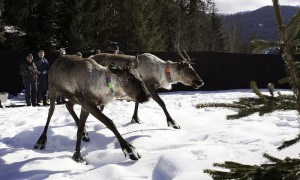
At birth, a caribou calf slips from its mother to the ground, a tangle of endless limbs and slick fur. After a cleaning from its mother, the calf struggles to stand, its weight tenuously supported on broad hooves that will eventually serve as snowshoe-like supports for travelling through deep snow, and paddles for fording swift rivers. The calf will walk within its first hour, and most can outrun a human within a day. It must—the first days of life are its most vulnerable.
“For caribou, the highest risk of death is in the first month of life, and it’s usually caused by predation,” said Dr. Rob Serrouya, science advisor to the Revelstoke Caribou Rearing in the Wild project (RCRW). The project aims to bolster calf survival in a dwindling sub-population of Southern Mountain Caribou near Revelstoke.
Though predation from animals like wolves and bears is a natural source of mortality for caribou, decades of habitat alteration in the Southern Mountain Caribou range has favoured a build up of predators, and tipped the delicate balance creating predation levels that caribou herds cannot withstand. This is one of the reasons why the Committee on the Status of Endangered Wildlife in Canada (COSEWIC) lists Southern Mountain Caribou as endangered.
The RCRW project is an effort to right the scales. In 2014, Serrouya and others captured nine pregnant females in the spring, penned them within their natural habitat, and then fed and protected them—and eventually their newborns—until most of the calves were a month old. Of the nine calves released into the wild with their mothers, seven are still living (a wolf killed one, and another is missing for reasons unknown).
“The current survival rate is more than double what it would be compared with other wild populations where this has been studied,” said Serrouya. The herd is estimated to be between 130 and 150 individuals.
Part of the project’s success, according to Serrouya, is due to the efforts to control other factors affecting the decline of the herd. “The key point is that this has been done in conjunction with extensive habitat protection,” he said, adding that simply increasing the number of calves is not enough to bring them back from the brink. Serrouya said significant efforts have been made to set aside quality habitat for caribou—even land that has value for industries like forestry.
While maternal penning has shown early success for the Southern Mountain Caribou population, it’s not necessarily the answer for all caribou herds in need of recovery.
John Wilmshurst, resource conservation manager in Jasper National Park, said that although the RCRW project is of great value to regional conservation efforts, maternal penning is not being considered in Jasper because calf survival is not driving the low caribou numbers in the park.
He said that in Jasper, the yearly caribou calf survival rate is 28 per cent, as compared to the 10 to 15 per cent observed on provincial land in Alberta.
“We don’t see caribou calf survival as a problem in Jasper. Our bigger problem is adult female survival.”
Wilmshurst explained that in Jasper National Park not enough females survive for the population to persist. “Maternal penning does not solve this problem.”
Back near Revelstoke though, increasing calf survival in protected habitat could make all the difference, and not just to caribou. Serrouya said maternal penning is one way to reduce predation pressure without having to kill predators like wolves—a technique currently used in Alberta to reduce kills in vulnerable caribou herds. Perhaps this is one reason why the project has such broad support from a variety of organizations.
“It’s a win-win on many fronts,” said Serrouya.
Niki Wilson
Special to the Fitzhugh
